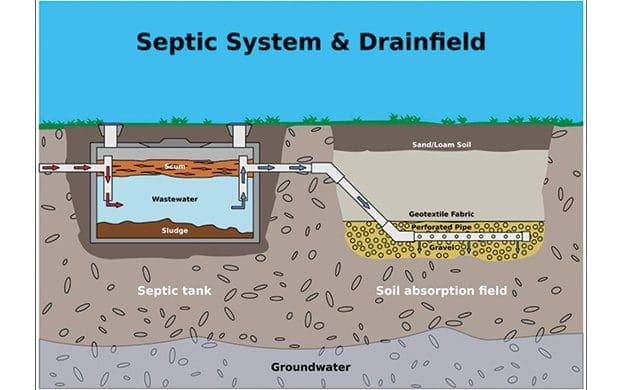
Septic Systems Costa Rica
Septic Systems Costa Rica: As mentioned in my June 2017 Howler article about plumbing, septic systems play an important role in the treatment, recycling and reuse of wastewater from Costa Rican homes. Many residents here have experienced backed-up septic systems during the rainy season. It’s a very common problem with older systems, most of which are poorly designed and built. More recent options have become available for treating and reusing wastewater in Costa Rica, rather than just disposing of it. What all of these systems have in common is a mechanism for breaking down the organic matter found in wastewater, making it very important to prevent the introduction of harmful and toxic chemicals, soaps and detergents. Septic Systems Wastewater.
The importance of proper capacity and construction
of septic drain fields cannot be overemphasized.
Wastewater can be categorized into two groups: black water and gray water. Black water comes from your toilet. It contains coliform bacteria and therefore must go into a septic or water treatment system. Gray water comes from sinks, showers and washing machines. The lack of coliform bacteria means it can be separated and reused or sent elsewhere.
Since there is no sewer system connected to a public water treatment plant in Guanacaste, every individual property in the area needs its own wastewater treatment system. Typically, these are standard septic systems with an associated drainage field. The system is designed to separate sludge — objects and solids that sink to the bottom — and floating debris such as oil and grease. These remain in the first tank, while water from the middle of the tank passes through the plumbing into the second tank. The second tank is basically a holding tank for the cleaner water, which then passes slowly into the drainage field. The drainage field should be relatively long and about 6 feet deep. It’s filled with porous materials such as rock, sand or debris that allows the water to percolate into the soil. Eventually this water makes it into the water table below, which is why a correctly designed system is essential to ensure the breakdown of coliform and other bacteria.
Other Building Costa Rica Articles
Built-in Safety by Design
Understanding Tico Plumbing
Picking the Right Windows
Swimming Pools, Design, Construction and Maintenance
The Importance of Home Inspection
From Dream to Reality
Picking Your Dream Property
Roofing 101: Guanacaste Style
Guanacaste Tropical Hardwoods
Going with the Flow: Rain Runoff and Erosion
The importance of proper capacity and construction of septic drain fields cannot be overemphasized, with septic system backup being a fairly common problem here. Every year or two during rainy season, septic system backups prevent toilets, sinks and showers from draining. There is often a foul smell, and promptly a truck is called to drain the tank. In almost all instances, the cause is a saturated drain field. Either the soil itself has flooded and can no longer drain, or the drainage basin is not big enough and cannot handle the load of water being dispersed into it. If this is an ongoing problem, the usual recommendation is to install a new drain field, likely much bigger the the current one. Almost in all instances, the septic tank itself is fine, but the drain field is undersized or incorrectly built.
The next Howler article will discuss alternatives to a septic system, including cheap and easy ways to recycle gray water at home. We’ll also look at more expensive systems for cleaning and treating both gray and black water for use in gardens and irrigation, potentially saving thousands of gallons of water a month.
